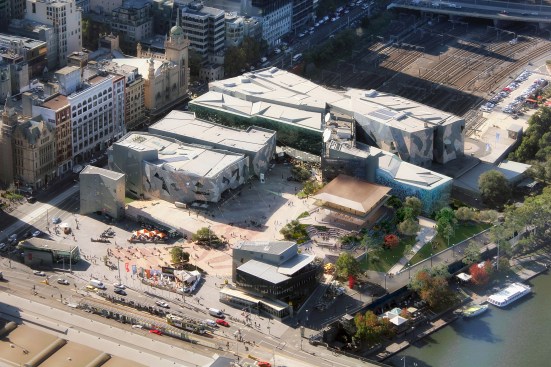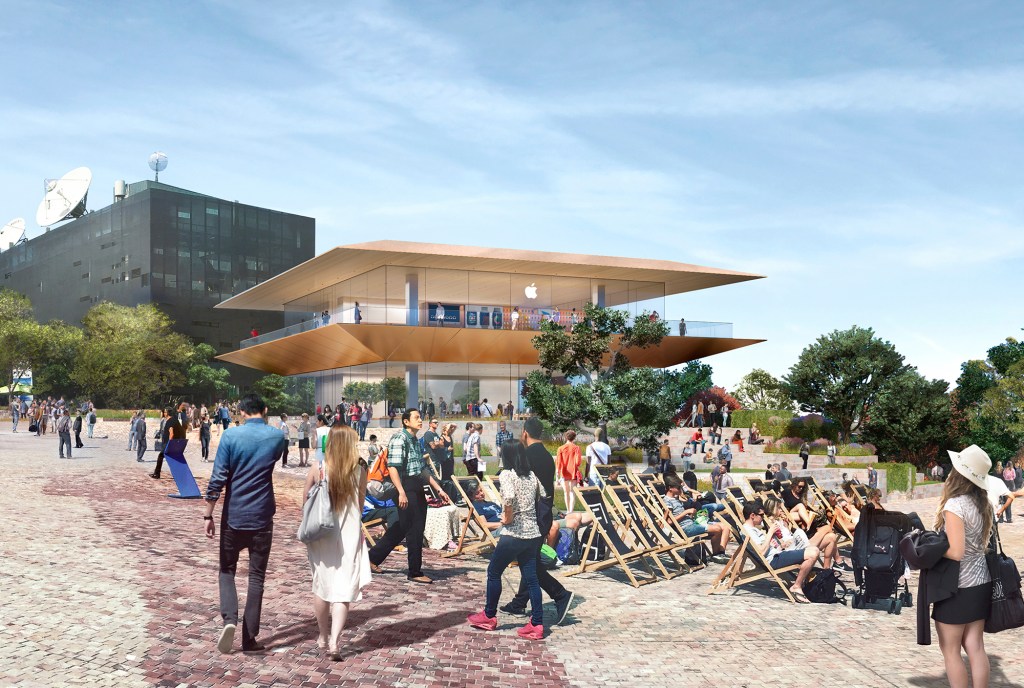In late December, Apple announced a new southern-hemisphere flagship project in Melbourne, Australia’s Federation Square, declaring, “Apple Federation Square will create a new destination where the community can gather, shop, be inspired, educated and entertained.”
However, residents are not as enthusiastic about the changes to the public square, which welcomes more than 10 million visitors annually. In fact, a local group has already established a protest campaign to stop the retailer from opening the new store location.
Slated for completion in 2020, the two-story structure designed by Foster + Partners will replace an existing structure, the Yarra Building, forcing the relocation of the Koorie Heritage Trust—an Aboriginal culture center— that occupies the space. The new construction will occupy a smaller footprint, creating more than 5,000 square feet of new public space alongside the Yarra River. In addition to housing the Apple retail space, the building will also host workshops, classes, and live music events.

Courtesy Apple Inc.
While the original Federation Square lead architect Donald Bates, design director of Lab Architecture Studio in Melbourne, has “given his tick of approval” for the new construction, according to a press release from Federation Square officials, protestors are condemning the demolition of the Yarra Building, with almost 45,000 signatories demanding the preservation of the structure on a Change.org petition. “I knew that my decision (it’s mine alone) to support the changes to Federation Square and allow an Apple Concept Store to replace the Yarra Building would be controversial,” Bates writes in an op-ed article. “The Yarra Building has remained problematic in its utilization. There have been numerous iterations of tenants and occupation, none overly successful. Even the current tenancy of the Koori Heritage Trust is compromised by the lay-out of the building. It remains a somewhat orphaned building. My assessment is that under all past and currently proposed scenarios, the replacement of this one part of the original design is acceptable.” (Read Bates’ full defense here.)
Many are also critical of the Victoria government’s “shady” decision to bypass public notice, according to the protest campaign, though Federation Square officials cite “state significance” and “timely decision [making]” as key factors in skipping this convectional step in public project planning. In response to this decision, the Planning Institute Australia, the Australian Institute of Landscape Architects, and the Australian Institute of Architects penned an open letter to the Victoria Minister of Planning, Richard Wynne expressing their concern “over the lack of a clear and transparent planning process with no opportunity for community consultation for such a significant development in Melbourne’s most iconic public square,” they write. “Collectively, we advocate for the de-politicization of the planning process and such a decision will only set a precedent for poor planning decisions in the future.”
This is not the first time Apple has stirred neighborhood tension. In 2015, residents of New York City’s Upper East Side opposed the adaptive reuse of the circa-1920 U.S. Mortgage and Trust Co. building. Ultimately, Apple successfully constructed a store on the site.
Foster + Partners declined to comment and, at the time of this story’s publication, Apple did not respond to a request for comment.
